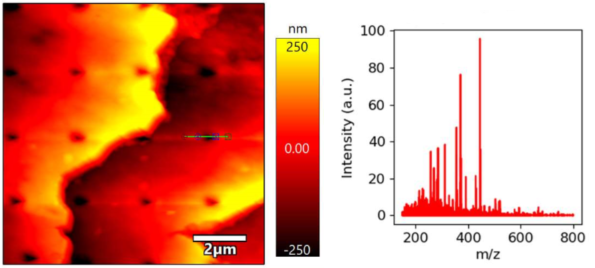Chemical Imaging
Background
Molecules and atoms are the fundamental building blocks of all mater. The type of each molecule or atom and how it interacts with its surroundings ultimately determine the function and properties of the system. The human body contains more than 200 different types of cells each containing millions of molecules interacting with an enormous degree of complexity. In mechanical structures such as buildings, automobiles, and packaging the molecular and atomic compositions of each component material is often chosen to optimize the performance of the system. Modern computers have been able to sustain their enormous growth in computational power due to the ability to precisely engineer the atomic composition and arrangement of their smallest components
Results
The combination of atomic force microscopy and mass spectrometry (AFM-MS) can enable molecular imaging at length scales less than 1 um. In AFM-MS a sharped tip is brought into contact with a sample and then rapidly heated. This causes material to thermally desorb from the surface in a small crater surrounding tip-sample contact. This desorbed material is then picked up in a transport gas, carried to an ionization stage, and then transported into a mass spectrometer for analysis. The image on the right shows and AFM-MS experiment conducted on human hair. The topography image shows the thermal desorption craters on the hair surface. The mass spectrum correlated with the thermal desorption event shows several chemical species know to be in the shampoo with which the hair was washed.
